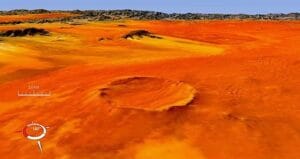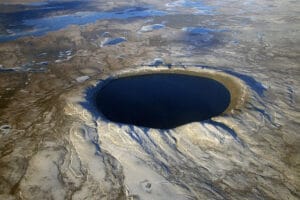Impact craters on earth are difficult to preserve due to the continuous remodeling of the earth’s crust by orogenesis, plate tectonics and atmospheric agents.
This thanks to the shield made by the earth’s dense atmosphere.
Others have instead brought wealth as the Popigai crater in Russia, whose impact transformed graphite into diamonds within about 13 km radius.
1. Vredefort Dome, South Africa: 160 km diameter, 2.02 billion years old.
2. Chicxulub crater, Mexico: 150 km diameter, 65 million years old.
3. Sudbury crater, Canada: 130 km diameter, 1.85 billion years old.
4. Popigai crater, Russia: 100 km diameter, 35 million years old.
5. Manicouagan crater, Canada: 100 km diameter, 214 million years old.
6. Acraman crater, Australia: 90 km diameter, 580 million years old.
7. Chesapeake Bay crater, USA: 85 km diameter, 35 million years old.
8. Morokweng crater, South Africa: 70 km diameter, 145 million years old.
9. Kara crater, Russia: 65 km diameter, 70 million years old.
10. Beaverhead crater, USA: 60 km diameter, 600 million years old.
Well preserved impact craters on earth:
Aouelloul crater, Mauritania
3,1 million years old, 390 m diameter, 53 m depth.

Tenoumer crater, Mauritania
30.000 years old, 1,9 km diameter, 100 m depth.

The Roter Kamm crater, Namibia
5 million years old, 2,5 km diameter, 130 m depth.

Lonar crater lake, India
50.000 years old, 1,2 km diameter, 137 m depth.

Monturaqui crater, Chile
One million years old, 460 m diameter, 34 m depth.

Gosses Bluff crater, Australia
142 million years old, 6 km diameter, 180 m depth.

Pingualuit crater, Canada
1,4 million years old, 3,44 km diameter, 270 m depth

Amguid crater, Algeria
100.000 years old, 450 m diameter, 30 m depth

Wolfe Creek crater, Australia
300.000 years old, 875 m diameter, 25 m depth

Barringer crater, USA
40.000 years old, 1,2 km diameter, 170 m depth.

